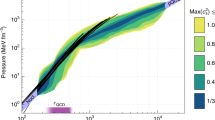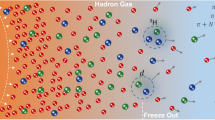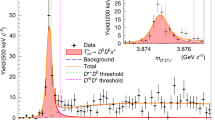Abstract
The essence of nuclear fusion is that energy can be released by the rearrangement of nucleons between the initial- and final-state nuclei. The recent discovery1 of the first doubly charmed baryon  , which contains two charm quarks (c) and one up quark (u) and has a mass of about 3,621 megaelectronvolts (MeV) (the mass of the proton is 938 MeV) also revealed a large binding energy of about 130 MeV between the two charm quarks. Here we report that this strong binding enables a quark-rearrangement, exothermic reaction in which two heavy baryons (Λc) undergo fusion to produce the doubly charmed baryon
, which contains two charm quarks (c) and one up quark (u) and has a mass of about 3,621 megaelectronvolts (MeV) (the mass of the proton is 938 MeV) also revealed a large binding energy of about 130 MeV between the two charm quarks. Here we report that this strong binding enables a quark-rearrangement, exothermic reaction in which two heavy baryons (Λc) undergo fusion to produce the doubly charmed baryon  and a neutron n (
and a neutron n ( ), resulting in an energy release of 12 MeV. This reaction is a quark-level analogue of the deuterium–tritium nuclear fusion reaction (DT → 4He n). The much larger binding energy (approximately 280 MeV) between two bottom quarks (b) causes the analogous reaction with bottom quarks (
), resulting in an energy release of 12 MeV. This reaction is a quark-level analogue of the deuterium–tritium nuclear fusion reaction (DT → 4He n). The much larger binding energy (approximately 280 MeV) between two bottom quarks (b) causes the analogous reaction with bottom quarks ( ) to have a much larger energy release of about 138 MeV. We suggest some experimental setups in which the highly exothermic nature of the fusion of two heavy-quark baryons might manifest itself. At present, however, the very short lifetimes of the heavy bottom and charm quarks preclude any practical applications of such reactions.
) to have a much larger energy release of about 138 MeV. We suggest some experimental setups in which the highly exothermic nature of the fusion of two heavy-quark baryons might manifest itself. At present, however, the very short lifetimes of the heavy bottom and charm quarks preclude any practical applications of such reactions.
This is a preview of subscription content, access via your institution
Access options
Access Nature and 54 other Nature Portfolio journals
Get Nature+, our best-value online-access subscription
$29.99 / 30 days
cancel any time
Subscribe to this journal
Receive 51 print issues and online access
$199.00 per year
only $3.90 per issue
Buy this article
- Purchase on Springer Link
- Instant access to full article PDF
Prices may be subject to local taxes which are calculated during checkout


Similar content being viewed by others
Change history
30 November 2017
Please see accompanying Erratum (http://doi.org/10.1038/nature25141). In this Letter, on the right-hand side of the fifth line of equation (2), ‘3He p’ should read ‘4He p’. This error has been corrected online.
References
The LHCb Collaboration. Observation of the doubly charmed baryon
 . Phys. Rev. Lett. 119, 112011 (2017)
. Phys. Rev. Lett. 119, 112011 (2017)Karliner, M. & Rosner, J. L. Baryons with two heavy quarks: masses, production, decays, and detection. Phys. Rev. D 90, 094007 (2014)
Karliner, M . & Rosner, J. L. Discovery of doubly-charmed
 baryon implies a stable
baryon implies a stable  tetraquark. Phys. Rev. Lett. (in the press); preprint at https://arxiv.org/abs/1707.07666 (2017)
tetraquark. Phys. Rev. Lett. (in the press); preprint at https://arxiv.org/abs/1707.07666 (2017)Atzeni, S . & Meyer-ter-Vehn, J. The Physics of Inertial Fusion Table 1.1, Ch. 1 (Oxford Univ. Press, 2004)
Gell-Mann, M. The Eightfold Way: A Theory of strong interaction symmetry. Report No. TID-12608; CTSL-20, https://www.osti.gov/scitech/servlets/purl/4008239 (California Institute of Technology, 1961)
Okubo, S. Note on unitary symmetry in strong interactions. Prog. Theor. Phys. 27, 949–966 (1962)
Gal, A., Hungerford, E. V. & Millener, D. J. Strangeness in nuclear physics. Rev. Mod. Phys. 88, 035004 (2016)
Harada, T., Hirabayashi, Y. & Umeya, A. Production of doubly strange hypernuclei via Ξ− doorways in the 16O(K−, K+) reaction at 1.8 GeV/c. Phys. Lett. B 690, 363–368 (2010)
Dover, C. B. & Gal, A. Ξ hypernuclei. Ann. Phys. 146, 309–348 (1983)
Wang, M. et al. The AME2016 atomic mass evaluation (II). Tables, graphs and references. Chinese Phys C. 41, 030003 (2017); data available at https://www-nds.iaea.org/relnsd/vcharthtml/VChartHTML.html.
The LHCb Collaboration. RICH Technical Design Report. Report No. LHCC 2000-037, http://lhcb.web.cern.ch/lhcb/rich/pdf/richtdr.pdf (CERN, 2000)
The LHCb Collaboration. Measurement of the B± production cross-section in pp collisions at
 = 7 TeV. J. High Energy Phys. 4, 93 (2012)
= 7 TeV. J. High Energy Phys. 4, 93 (2012)The LHCb Collaboration. Measurement of B meson production cross-sections in proton-proton collisions at
 = 7 TeV. J. High Energy Phys. 8, 117 (2013)
= 7 TeV. J. High Energy Phys. 8, 117 (2013)The LHCb Collaboration. Study of the production of
 and
and  hadrons in pp collisions and first measurement
hadrons in pp collisions and first measurement  of the branching fraction. Chinese Phys. C 40, 011001 (2016)
of the branching fraction. Chinese Phys. C 40, 011001 (2016)Dainese, A. Heavy-quark production in heavy-ion collisions. J. Phys. Conf. Ser. 446, 012034 (2013)
Grelli, A. Experimental overview on heavy-flavor production. J. Phys. Conf. Ser. 832, 012020 (2017)
Schaffner, J., Dover, C. B., Gal, A., Greiner, C. & Stoecker, H. Strange hadronic matter. Phys. Rev. Lett. 71, 1328–1331 (1993)
Schaffner, J. et al. Multiply strange nuclear systems. Ann. Phys. 235, 35–76 (1994)
Author information
Authors and Affiliations
Contributions
Both authors contributed equally to this work.
Corresponding author
Ethics declarations
Competing interests
The authors declare no competing financial interests.
Additional information
Reviewer Information Nature thanks G. Miller and S. Stone for their contribution to the peer review of this work.
Publisher's note: Springer Nature remains neutral with regard to jurisdictional claims in published maps and institutional affiliations.
PowerPoint slides
Rights and permissions
About this article
Cite this article
Karliner, M., Rosner, J. Quark-level analogue of nuclear fusion with doubly heavy baryons. Nature 551, 89–91 (2017). https://doi.org/10.1038/nature24289
Received:
Accepted:
Published:
Issue Date:
DOI: https://doi.org/10.1038/nature24289
This article is cited by
-
Erratum: Quark-level analogue of nuclear fusion with doubly heavy baryons
Nature (2018)
-
Quarks fuse to release energy
Nature (2017)
Comments
By submitting a comment you agree to abide by our Terms and Community Guidelines. If you find something abusive or that does not comply with our terms or guidelines please flag it as inappropriate.




 . Phys. Rev. Lett. 119, 112011 (2017)
. Phys. Rev. Lett. 119, 112011 (2017) baryon implies a stable
baryon implies a stable  tetraquark. Phys. Rev. Lett. (in the press); preprint at
tetraquark. Phys. Rev. Lett. (in the press); preprint at  = 7 TeV. J. High Energy Phys. 4, 93 (2012)
= 7 TeV. J. High Energy Phys. 4, 93 (2012) = 7 TeV. J. High Energy Phys. 8, 117 (2013)
= 7 TeV. J. High Energy Phys. 8, 117 (2013) and
and  hadrons in pp collisions and first measurement
hadrons in pp collisions and first measurement  of the branching fraction. Chinese Phys. C 40, 011001 (2016)
of the branching fraction. Chinese Phys. C 40, 011001 (2016)